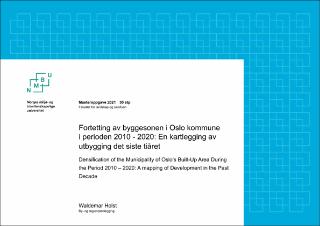| dc.contributor.advisor | Børrud, Elin | |
| dc.contributor.author | Holst, Haakon Waldemar Charlie Chandl | |
| dc.coverage.spatial | Norway, Oslo | en_US |
| dc.date.accessioned | 2021-09-29T18:23:51Z | |
| dc.date.available | 2021-09-29T18:23:51Z | |
| dc.date.issued | 2021 | |
| dc.identifier.uri | https://hdl.handle.net/11250/2786403 | |
| dc.description.abstract | Oslos befolkning vokser fort og prognoser viser at den vil fortsette å stige mot 2050. For å håndtere befolkningsveksten på en bærekraftig måte skal det bygges tett. Oslos byggesone er, siden Markaloven kom i 2009, fastsatt med klare grenser mot mark, fjord og nabokommuner, og de ledige arealene er begrenset. Løsningen er den kompakte byen.
I 2005 gjorde Børrud en kartlegging av utbyggingen av Oslos byggesone i perioden 1985 til 2000. En tilsvarende kartlegging ble gjort i 2010 av Syvertsen, for perioden 2000 til 2010. Alle nye bygg, samt om- og påbygg over 500 kvm til byggesonen ble kartfestet til byggesonen. Utbyggingen ble kartlagt opp mot forskjellige faktorer for å undersøke hva som påvirker utbyggingen, samt opp mot områdetyper for å kartlegge eventuell transformasjon.
I denne oppgaven gjøres en tilsvarende kartlegging for perioden 2010 til 2020, for å undersøke problemstillingen om hvordan Oslos byggesone har endret seg gjennom fortetting. Det benyttes en typo-morfologisk metode for å kartlegge utbyggingen det siste tiåret. Dette analyseres så opp mot mulig påvirkende faktorer som områdetyper, infrastruktur, vedtatte kommunale planer og vern av områder og bygg. I kartleggingen brukes data fra Oslo kommune, Matrikkelen, Byantikvaren og andre offentlige dataregistre.
Kartleggingen viser at enkelte utbyggingstendenser som ble registrert i kartleggingene fra 2005 og 2010 har vedvart, andre har dabbet av og nye tendenser har blitt registrert. Kartleggingen registrerer at småhusområdene fortettes og større grad av utbygging av områder med arealintensiv næring transformeres til tette boligområder. | en_US |
| dc.description.abstract | The population of the Municipality of Oslo is growing, and forecasts show an additional increase by the year 2050. To deal with an increasing population in an environmentally friendly manner the strategy is to build more densely. Since the forest protection act (Markaloven) was passed in 2009 Oslo have a clear delimitation of a built-up area, with a limited amount of free land. The solution is a compact city.
In 2005 Børrud mapped the development of the built-up area in the municipality of Oslo in the period 1985 to 2000. An equivalent mapping was later done in 2010 then Syvertsen mapped the development in the period 2000 to 2010. All new buildings, as well as conversions and extensions of the existing buildings of 500 sqm, was pinned to the built-up area and mapped. The development was mapped against various factors to investigate their influence, as well as against area types to map any transformation.
In this thesis, I will conduct an equivalent mapping for the period 2010 to 2020 to investigate the thesis question of how densification in the past decade has influenced the built-up area of the municipality of Oslo. The method of typo-morphologic analysis was applied to map and analyzed the development of the past decade to find any context between development and various factors that might have influenced the development, such as area types, infrastructure, passed zoning plans and protections of areas and buildings. The mapping is based on data gathered from the municipality of Oslo, the cadaster (Matrikkelen), the Cultural Heritage Management Office (Byantikvaren) and other public data registers.
The mapping shows that some development tendencies that were recorded in the two first mappings have prevailed, some have declined as well as some new tendencies. The mapping registers that small house areas are densified, and larger area-intensive commercial areas are transformed into new dense housing areas. | en_US |
| dc.language.iso | nob | en_US |
| dc.publisher | Norwegian University of Life Sciences, Ås | en_US |
| dc.rights | Attribution-NonCommercial-NoDerivatives 4.0 Internasjonal | * |
| dc.rights.uri | http://creativecommons.org/licenses/by-nc-nd/4.0/deed.no | * |
| dc.subject | Fortetting | en_US |
| dc.subject | Oslo kommune | en_US |
| dc.subject | kartlegging | en_US |
| dc.subject | morfologi | en_US |
| dc.subject | transformasjon | en_US |
| dc.subject | byplanlegging | en_US |
| dc.subject | utbygging | en_US |
| dc.subject | utbyggingstendenser | en_US |
| dc.title | Fortetting av byggesonen i Oslo kommune i perioden 2010-2020 : en kartlegging av utbygging det siste tiåret | en_US |
| dc.title.alternative | Densification of the municipality of Oslo’s built-up area during the period 2010–2020 : a mapping of development in the past decade | en_US |
| dc.type | Master thesis | en_US |
| dc.subject.nsi | VDP::Samfunnsvitenskap: 200 | en_US |
| dc.description.localcode | M-BYREG | en_US |

